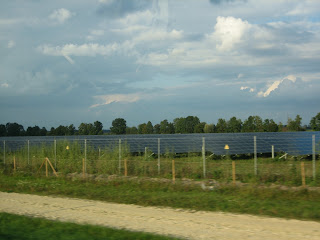a bunch of basil, it depends on how much you are making
pine nuts
garlic
parmesan cheese
lemon zest
olive oil

Put the first four ingredients into a food processor and start to process. While processing slowly dribble some olive oil into the bowl. You might have to stop and scrape the sides down a couple times.
Hints: Always wash your lemon before zesting. I used a little more cheese than normal so the color is not as green. I also like the lemon zest because especially on fish I feel it adds a little something. You do not need to add any salt because of the cheese and the lemon. If you ever want to have a bit more salt taste to a dish, if it won't ruin the flavor, add some lemon zest. This won't give you the sodium but will bring out every single flavor more intensely.
Substitute: If you don't have much basil but have a bunch of spinach on hand you can use the spinach and whatever basil you do have. The basil has such an intense flavor that it will come out but your batch will be bigger. It also adds a lot of calcium from the spinach, one of the super foods. (If your kids or husband don't like spinach this will hide it from them.)
I coated my salmon with my pesto and baked at 350 for about 25 minutes. The time all depends on how big of a filet you have, just stick a fork into the thickest part and if it flakes then it's done. Mine was probably big enough for four adults so we had leftovers.


If you are going to buy salmon the best and most ecologically friendly salmon you can buy is wild caught Alaskan salmon. Farm raised might taste pretty good and look the same but there are many things under the surface that are different.
1. They are now feeding salmon a corn meal just like they have made cows eat corn.
2. Color added. Have you ever wondered how they add that color? Well, I know and will share. When people started to farm salmon they were putting them in large holding tanks and feeding them fish meal. Salmon in the wild eat other fish and plankton. The plankton eats sea vegetables, like algae. This algae has beta carotene in it. In turn, when the salmon eat the plankton they are eating beta carotene which turns their flesh that "salmon" color we know and love. Farmed fish do not get the beta carotene from the fish meal they are fed and so the farmers were finding that when they killed their salmon and cut them open they were a white color. They knew that buyers were not going to buy white salmon so they thought of something. They approached pharmaceutical companies and made a deal for them to have their own color of pink for their fish. They create a dye which is put into their fish meal which then dyes their flesh that pink color we expect. So now you know what "color added" means. (Pretty crazy if you ask me.) (Oh and thanks to Colleen Patrick-Goudreau for that information which I heard on her podcast.)
So now you know and can make a little more informed choice about the type of salmon to buy and eat. Hope you enjoy the pesto recipe which is also great as a dip for veggies and in one of my favorite pasta dishes. (London likes to lick the spoon and bowl after I make it.)
Namaste!















